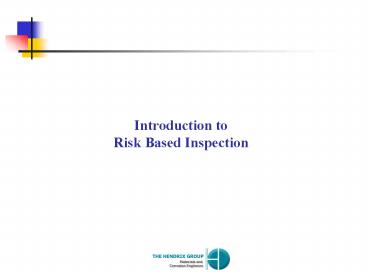Introduction to Risk Based Inspection PowerPoint PPT Presentation
1 / 11
Title: Introduction to Risk Based Inspection
1
Introduction to Risk Based Inspection
2
Definitions
- Risk allows people to view potential hazards that
simultaneously accounts for both the likelihood
and consequences of an event. - Risk Based Inspection (RBI) is a systematic tool
that helps users make informed business decisions
regarding inspection and maintenance spending.
3
RBI Capabilities
- RBI has the capability to do the following
- Evaluate current inspection plans to determine
priorities for inspections - Evaluate future plans for decision making
- Evaluate changes to basic operations as they
affect equipment integrity - Identify critical contributors to risk that may
otherwise be overlooked - Establish economic optimum levels of inspection
as weighed against risk reduction - Incorporate Acceptable Risk levels
4
Measuring Risk
- Risk is a combination of likelihood and
consequence. - One way to illustrate risk is to display the
likelihood and consequence factors on an X-Y plot.
5
Likelihood and Consequence X-Y Plot
6
Iso Risk Lines
7
Semi-Quantitative Risk Matrix
8
RBI Analysis Comparison
9
API 581 RBI Levels of Analysis
- The API RBI procedure has three levels of
analysis - Level I - screening tool that quickly highlights
the high-risk equipment that users may wish to
assess in greater detail. - Level II - a step closer to being a quantitative
analysis than Level I, and it is a scaled down
approach of Level III. Provides most of the
benefit of Level III analysis, but it requires
less input than Level III. - Level III - quantitative approach to RBI
providing the most detailed analysis of the three
levels.
10
Why do we Need RBI?
- Most inspection codes/standards based on LOF, not
COF - Reduce risk of high consequence failures
- Improve the cost effectiveness of inspection and
maintenance resources - Provide a basis for shifting resources from lower
to higher risk equipment - Measure and understand the risks associated with
current inspection programs - Measure risk reduction as a result of inspection
practices
11
Benefits of an RBI Program
- The basic benefits of an RBI program are as
follows - It provides the capability to define and measure
risk, creating a powerful tool for managing many
of the important elements of a process plant. - It allows management to review safety in an
integrated, cost-effective manner. - It systematically reduces the likelihood of
failures by making better use of the inspection
resources. - AND
- It improves the reliability of plant equipment.

